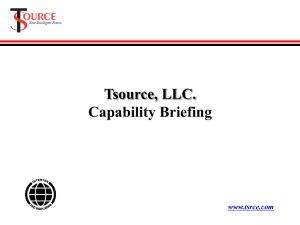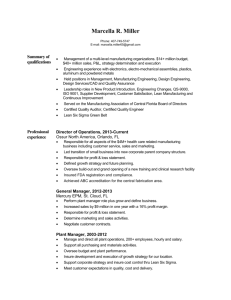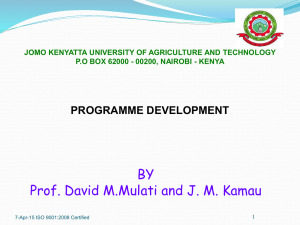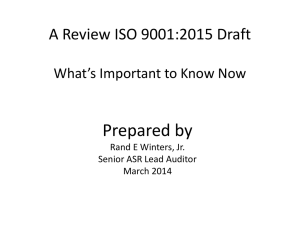Introduction
advertisement
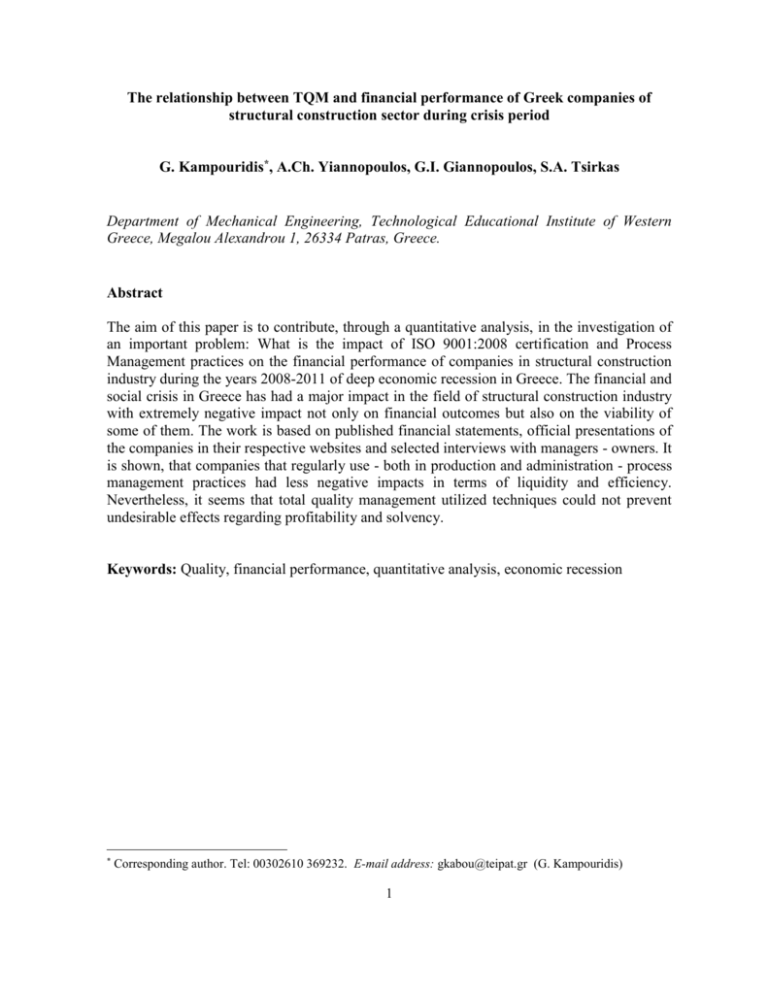
The relationship between TQM and financial performance of Greek companies of structural construction sector during crisis period G. Kampouridis*, A.Ch. Yiannopoulos, G.I. Giannopoulos, S.A. Tsirkas Department of Mechanical Engineering, Technological Educational Institute of Western Greece, Megalou Alexandrou 1, 26334 Patras, Greece. Abstract The aim of this paper is to contribute, through a quantitative analysis, in the investigation of an important problem: What is the impact of ISO 9001:2008 certification and Process Management practices on the financial performance of companies in structural construction industry during the years 2008-2011 of deep economic recession in Greece. The financial and social crisis in Greece has had a major impact in the field of structural construction industry with extremely negative impact not only on financial outcomes but also on the viability of some of them. The work is based on published financial statements, official presentations of the companies in their respective websites and selected interviews with managers - owners. It is shown, that companies that regularly use - both in production and administration - process management practices had less negative impacts in terms of liquidity and efficiency. Nevertheless, it seems that total quality management utilized techniques could not prevent undesirable effects regarding profitability and solvency. Keywords: Quality, financial performance, quantitative analysis, economic recession * Corresponding author. Tel: 00302610 369232. E-mail address: gkabou@teipat.gr (G. Kampouridis) 1 1. Introduction The intensive competition, the continuous technological evolution, the globalization tendency enforce the suppliers to provide high quality products and services in very competitive prices especially in recession economic environment. Quality is a very important tool for the survival and evolution of a modern enterprise. There are many definitions for quality, but the authors of this paper accept the Reeves and Bednar (1994) approach: The extent to which a product meets and/or exceeds customers’ expectations. The companies in order to stay competitive in the global market are continuously in an effort to improve their operational performance by adopting management process practices that often included in the ISO 9001:2008 standards. The International Organization of Standards (ISO) firstly published ISO 9001 quality management system in 1987. Since then, ISO 9001 was revised in 1994, 2000 and 2008. The recent version of the standard (ISO 9001:2008) includes a set of guidelines that encompasses the Total Quality Management (TQM), which is one of the most favorable Process Management Practices. Moreover, the certification requires certain documentation on the operational procedures and utilized managerial actions to achieve that the facility can provide products that consistently meet customer and applicable regulatory requirements. However, buyers often have difficulties in identifying suppliers that provide the required product quality, because the underlying quality attributes are difficult to be measured. As a result customers of the structural construction sector demand the adoption of ISO 9001:2008 by the supply partners. In this way, attributes that have been used during the manufacturing process as well as related materials that should be incorporated in the final product are straightforwardly revealed. Especially all the important competitors who belong to the Greek structural construction sector have been certified according to ISO 9001 since 2008. The specific way of implementing managerial practices which are aimed at improving operational effectiveness of each organization is crucially important (Porter, 1996). The corresponding certificate has the internal power to effectively guide the organizations to establish firm-specific organizational routines and processes that are difficult to be imitated by the competitors and therefore to gain a sustainable competitive advantage (Peteraf, 1993). There is an extensive body of literature about the influence of the implementation of TQM and ISO standardization on financial performance of several types of companies. Hendricks and Singhal (2000) have used a sample of quality award winners to empirically test hypotheses that relate changes in operating income associated with effective implementation of TQM to various firm characteristics. Martinez-Lorente and MartinezCosta (2004) have analysed a sample of 442 of the biggest Spanish manufacturing companies to examine the influence of TQM on the companies’ operating performance. Sharma (2005) has explored the association between ISO 9000 certification and financial performance at the organizational level in a mature quality initiative market. Benner and Veloso (2008) have used longitudinal panel data on ISO 9000 practices for firms in the auto supplier industry to study two new issues related to the adoption of process management practices. Wayhan et al. (2010) have tried to answer if ISO 9000 certified firms have a competitive advantage over non-certified companies, as evidenced by superior financial performance. Shahin (2011) has considered the most popular indicators of the financial performance and statues of organization, to indicate that TQM can have strong and positive influence on financial performance and status of the organization. Ghadiri et al. (2013) has studied the relationship 2 between TQM and financial performance of accepted companies in the Tehran stock exchange. However, the impact of economic crisis on the effectiveness of TQM tools has not been studied to a wide extent. Very recently, Callejo (2012) has made an effort to evaluate the implementation of TQM by a leading supermarket company to face the Spanish economic crisis. Greece, being in a severe social and financial crisis in the last few years, seems to be the ideal case study. In recent years, the ISO 9001:2008 standard based Quality Management System (QMS) has been widely implemented in the Greek industrial field. However, the studies regarding the influence of TQM and ISO with respect to Greek companies. Fotopoulos et al. (2010) have examined the inter-relationships of TQM practices in ISO 9000 certified organizations in Greece. Later, Ismyrlis and Moschidis (2013) have analyzed the level of use of quality management systems (QMS) and quality tools/techniques in ISO 9001:2008 certified Greek companies. To the authors’ best knowledge the TQM influence on steel construction industry under conditions of deep recession has not been investigated yet. The aim of the present study is to investigate, via a quantitative analysis, the real ISO 9001 quality certification effect on the financial performance of Greek steel construction industries which have been heavily influenced by the enduring crisis. For this purpose, a research concerning a variety of certified Greek structural construction industries is being conducted in an effort to correlate corresponding specific financial indicators, calculated by official financial performance reports, with ISO 9001 application within such a financial environment. 2. Theoretical background of ISO 9001:2008 Proponents of process management practices cite expectations of improved quality and efficiency, leading to increased revenue, reduced costs and ultimately, higher profits (Garvin, 1995: Harry and Schroeder, 2000). Such practices may be accomplished by the implementation of the extremely popular ISO quality standards. The latest fourth revision of them, i.e. the 9001 certificate appeared in 2008, is more customer-focused than the earlier ones. After the appearance of ISO 9001:2008, the number of certified companies is increasing constantly (Karthi et al. 2012). A recent European research concerning the companies certified with ISO 9001 standards has indicated that Greek companies are still in the phase of further expanding their quality systems (Franceschini et al. 2011). The ISO 9001 quality certification program as a process management program focuses on the improvement of an organisation’s operating process concerning quality and efficiency. Although ISO 9001 certification has been globally pursued and implemented and has been associated with more objective measures of performance remains an empirical issue. If ISO 9001 certification is not positively associated with financial performance, it may possibly lose credibility and be regarded as another management fad. It is conceivable that the self rated benefits are a selffulfilling prophecy. Due to its recent development, the ISO 9001 certification has not been investigated to the same extent as the previous ISO versions. Heuvel et al. (2005), has observed a number of advantages by using ISO 9001 in hospitals. Specifically, he has noticed that measurements lead to the improvement of quality of care since the corresponding documentation system serves the organization's needs without leading to bureaucracy. Feng et al. (2008) has 3 surveyed 613 ISO 9001 certified manufacturing and service organisations in Australia and New Zealand in order to explore the relationships between ISO 9001 quality standards and the resulting organisational performance. The results yielded both positive and significant relationships. Specifically, productivity, product quality and internal customer satisfaction as well as sales growth, profitability and market share have been found to be improved. HerasSaizarbitoria et al. (2011) has concluded that the implementation of ISO 9001 standard has led to the improvement of the efficiency and internal control of firms, especially considering the decision-making process and the amount of improvisation. The purpose of the research that follows is to investigate the association between ISO 9001 and the Greek steel construction sector during the financial crisis and specifically during the heavy recession years 2009-2011. As aforementioned, very few if any studies have explored the recession impact on objective measures of financial performance. This study fills the current void in the literature and addresses an important policy and strategic issue. 3. Greek recession and impacts The Greek economic crisis was generated by the appearance of the global economic recession in 2008 while is believed to have been directly triggered by a combination of structural weaknesses of the Greek economy (Baltas 2013; Kouretas and Vlamis 2010; Lekakis and Kousis 2013). Greece is in the sixth year of recession, deeper than predicted, with unemployment reaching extraordinary levels and slow progress in structural reforms. The country is in an effort to restructure the economy in order to reestablish growth and create jobs. Figure 1 illustrates the annual variation of Greek Gross Domestic Product (GDP) GTP since 2004. The deep recession period starting form year 2008 becomes obvious. 8 6 GDP growth (%) 4 2 0 -2 -4 -6 Greece -8 2004 2005 2006 2007 2008 2009 2010 2011 2012 Year Figure 1: Annual Greek GDP (Source: World DataBank). Inevitably, Greek industrial production was led to a deep fall by recession while the sector of construction perhaps suffered the most. Relevant data published by Hellenic 4 Statistical Authority (ELSTAT) show that construction output continues to decline significantly from 2008 until today (Figure 2). Production index in construction (%) 200 Base year 2005 (100%) 180 160 140 120 100 80 60 40 20 0 2004 Greece 2005 2006 2007 2008 2009 2010 2011 2012 Year Figure 2: Annual production index in construction in Greece (Source: ELSTAT). In the absence of native alternative heavy industries based on steel, the collapse of construction sector impacted fiercely the Greek steel production. Many companies have reduced the number of days of production while significant reductions in production and employment have been announced by all major steel groups. Nevertheless, the demand from construction steel-using sector remains subdued and the outlook for the Greek steel market is very uncertain. Figure 3 depicts the annual production of crude steel in Greece in contrast with steel product exports, imports as well as domestic usage in order to indirectly demonstrate the impact of recession on steel construction sector. 5500 5000 4500 Total Production of Crude Steel Exports of Semi-finished and Finished Steel Products Imports of Semi-finished and Finished Steel Products Use of finished steel products Steel weight (kt) 4000 3500 3000 2500 2000 1500 1000 500 2004 2005 2006 2007 2008 2009 2010 2011 2012 Year Figure 3: Annual steel production and usage in Greece (Source: Worldsteel Association). 5 Note that during the 2008-2011 period, the imports of steel products were significantly reduced. Simultaneously, corresponding exports took place in an increasing manner to satisfy the almost stable indigenous production of crude steel. However, continuously decreased usage of finished steel products, associated with the low demand for new steel based constructions within the economic crisis environment, over the last five years becomes apparent. 4. Steel construction sector profile in Greece Early works suggests that the extent of coherence or relatedness in a firm’s underlying technologies offers differential opportunities for creating firm-specific interactions and complementarities that can lead to competitive advantage (Hill and Hoskisson 1987). Since then the technology in Greek steel construction industry has been enormously advanced regarding hardware and management software to permit successful competition in the global market. The steel construction sector in Greece has marked significant growth during the last decade both in terms of project scale and delivery ability mainly due to the need for modern, innovative and ambitious structural solutions. Greek steel construction industries are specialized in manufacturing complex steel structures and products with high specifications and demanding requirements. The core activity of the Greek steel construction units is the production of tubular structures, heavyweight structures, steel buildings as well as industrial equipment and specialized structures for infrastructure facilities. Most of them may construct buildings using all types of sections and standardization while have the ability to provide integrated engineering solutions for special buildings. The majority of the manufacturing line of the specific industries utilize manufacturing technologies such as CNC welding, CNC cutting, die metal forming, galvanizing as well as simulation technologies in structural design while they contain fully equipped quality control laboratories. The specific industries are in accordance with ELOT standard ΕΝ ISO 9001/2008 while some of them follow firmly the technical requirements that should be taken into account for the execution of structural steelwork via BS EN 1090-2 specifications. Table 1 presents the basic organizational and financial measures of steel construction sector in Greece for the out of recession representative period 2000-2005. Table 1: Organizational and financial measures of Greek steel construction companies (Source: ESYE). 2000 2001 2002 2003 2004 2005 No of companies (>10 employees) 98 87 90 92 91 90 No of employees 4.175 4.122 4.454 4.676 4.624 4.399 Gross value of production (in k€) 337.097 341.372 395.534 466.100 504.055 510.912 Percentage of GDP (%) 0,237 0,225 0,238 0,259 0,266 0,251 The oligopoly of Greek steel construction field becomes apparent. Moreover, it is observed that an average of about fifty employees are occupied in the specific median 6 companies while the gross production is this field of industry in Greece reaches around 0.25% of the GDP. 5. Firm financial performance under recession environment 5.1 Data collection A sample of firms from a single industry, the Greek structural construction during the years 2005-2011 is being tested. The specific sector has been selected for the following main reasons: a. The specific industrial field is very sensitive in quality issues concerning their products. Actually it is not possible for them to participate in this sector if they don’t provide ISO 9001 certification fully implemented. Customers refuse to buy steel construction products without having proofs and evidences that the supplier implements in full the process management practices of ISO 9001. They also require that the utilized materials are as well certified. b. All the companies are certified according to ISO 9001 and thus have adopted process management practices, fact that enables the research on performance benefits arisen by process management. c. Using data from a single industry contributes to the control and homogeneity of research while other complications inherent in inter-industry analysis are avoided (Montgomery and Wernerfelt 1988). d. The use of a unique dataset is allowed which includes detailed and comparable information on technological characteristics of firms. e. In addition, the same resources of information for the whole sample is utilized i.e., the public reports of financial disclosures and the official websites of the companies. The employed data concerns a sample of 20 Greek relevant industries fully complying with ISO 9001:2008 since 2008. The research uses available data for the period 2005-2011. The financial information analysed encompass only the companies that publish their financial statements over the last years. The rest of the companies of the industry are small and medium companies, they use very limited technology and most probably they are not certified according to ISO 9001 standard. Also there is no reliable methodology to measure their financial performance, as far as they don’t publish their annual financial statements. Furthermore, the companies of the utilized sample have a continuously updated website which is a reliable source for collecting evidence regarding the certificates adopted by firms whereas provides valuable information about their facilities, technology and organisational structure. 5.2 Financial indicators before and after crisis There are many tools to survey the financial power and status of organizations, nonetheless perhaps the most effective way to estimate financial status of a company is the analysis of ratios. There are generally fifth groups of financial ratios by which the financial performance of an organization may be explored. These fifth groups include liquidity ratios, efficiency ratios, profitability ratios and solvency ratios. The calculation of the financial 7 ratios presented in the following are based on the analysis of the annual financial reports of the 20 ISO 9001 certified companies belonging to the Greek steel construction industry. The analysis took place for the year 2008 during which Greek recession has started as well as for up to 3 years prior (2005-2007) and 3 years after the crisis initiation (2009-2011). Figure 4 illustrates the mean variation of cash and current ratio versus time which express the average liquidity of these 20 companies over the years 2005-2011. The two liquidity ratios seem to increase both before and after crisis with a stable if not an ascending manner. However, it should be mentioned that it is not realistic for a company to purposefully maintain high levels of cash assets. This phenomenon may be seen as poor asset utilization to hold large amounts of cash which could be used elsewhere to generate higher returns. While providing an interesting liquidity perspective, the usefulness of this ratio is limited. The high values of these ratios may be due to the avoidance of investments in a recessionary environment. 1.7 1.6 Cash ratio Current ratio Liquidity ratios 1.5 1.4 1.3 1.2 1.1 1.0 0.9 2004 2005 2006 2007 2008 2009 2010 2011 2012 Year Figure 4: Annual liquidity indicators. Figure 5 demonstrates the average inventory and receivables turnover period of the industries under consideration over the years 2005-2011, characterizing their corresponding efficiency. After crisis, the receivables turnover ratio seems to increase to some extent. This is perhaps due to the limited market liquidity. However, the inventory turnover ratio, which is used to measure the inventory management efficiency of a business, shows a small descending behavior during years 2010 and 2011 as a result of the lack of market demand. The lower inventory turnover ratio may be an indication of over-stocking. 8 360 Receivables turnover ratio Inventory turnover ratio Efficiency ratios 300 240 180 120 60 2004 2005 2006 2007 2008 2009 2010 2011 2012 Year Figure 5: Annual efficiency indicators. Figure 6 depicts the average annual profit of the ISO 9001 certified steel construction sector via gross and net profit margins. Here the impact of the Greek crisis becomes clearer since profit margins, which are measurements of a company's manufacturing and distribution efficiency during the production process, present a declining after 2008. 30 Gross Profit Margin Net Profit Margin Profitability ratios (%) 25 20 15 10 5 0 -5 2004 2005 2006 2007 2008 2009 2010 2011 2012 Year Figure 6: Annual profit indicators. Figure 7 presents the return on invested capital and equity mean ratios of the companies under consideration versus time. Both return ratios, which may give a sense of how well a company is using its money to generate returns, are negatively influenced during recession period 2009-2011. 9 20 Return on equity Return on invested capital Profitability ratios (%) 15 10 5 0 -5 2004 2005 2006 2007 2008 2009 2010 2011 2012 Year Figure 7: Annual return indicators. Finally, Figure 8 depicts the time dependent average debt status of the tested industries through the debt to equity and interest coverage ratio. Debt to unity ratio is decreased during crisis. This may be seen as a lack of motivation to borrow and invest in an economic environment full of uncertainty. The descending behavior of interest coverage ratio and thus the difficulty in paying interest after 2008 becomes obvious. 10 Interest coverage ratio Debt to equity ratio Solvency ratios 8 6 4 2 0 2004 2005 2006 2007 2008 2009 2010 2011 2012 Year Figure 8: Annual solvency indicators. The outcomes from the present analysis are summarized in an effective way in Table 2. Specifically, the average financial state of the companies corresponding to the three years period before and after 2008 are put in contrast to emphasize the recession influence. The profitability and solvency issues of the steel construction companies after crisis become more obvious. 10 Table 2: Triennial financial indicators before and after the start of the crisis. Financial state Financial indicators Pro-crisis period 2005-2007 Start of recession 2008 Crisis period 2009-2011 Cash ratio 1.32 1.37 1.49 Current ratio 1.04 1.12 1.23 Inventory turnover ratio 167.69 183.98 212.87 Receivables turnover ratio 154.34 165.98 176.71 Gross profit margin (%) 19.89 21.92 17.95 Net profit margin (%) 5.68 3.79 1.86 Return on invested capital (%) 4.59 3.07 1.17 Return on equity (%) 13.28 7.43 3.22 Debt to equity ratio 1.68 1.56 1.18 Interest coverage ratio 7.15 5.07 4.02 Liquidity Efficiency Profitability Solvency 6. Conclusions The present study aimed on the investigation of the impacts of recession, such as the one facing Greece, on native steel construction industries which follow TQM implemented via the ISO 9001:2008 standardization. A significant sample of representative and ISO 9001:2008 certified companies belonging to Greek steel construction sector were examined according to their annual financial reports during the period 2005-2011. The analysis conducted showed that organizations which have adopted in time ISO 9001 presented notable degree of adjustment under conditions of deep recession in terms of liquidity. However, the calculated financial ratios showed that the corresponding sector, despite the fact that utilizes TQM tactics, was considerable influenced by recession in terms of its efficiency, profitability as well as solvency. The ISO 9001:2008 failure to prevent negative financial impact on steel construction industries possibly was caused by the following reasons: a. The severity of crisis itself eliminated the positive effects of ISO 9001:2008 and the steel construction sector was affected by the general trend of the economy. b. The ISO 9001:2008 is a rather new established certificate and thus its real impact is not revealed yet. c. TQM tools and techniques in Greek companies are not used suitably and to the appropriate extent. The proper establishment of the related projected standards, tools and techniques is not guaranteed in Greek reality. In the Greek case it seems that TQM techniques were not enough to absorb the negative impact of the Greek economic crisis on the steel construction sector, which now faces negative outcomes. 11 Acknowledgements The research is co-funded by the E.U. (European Social Fund) and national funds, action “Archimedes III – Funding of research groups in T.E.I.”, under the Operational Programme “Education and Lifelong Learning 2007-2013”. The authors wish to thank pro-graduate students L.K. Kiafas and L.S. Vasilakis for their help in analyzing the financial statements of the steel construction companies. References Baltas, N.C. (2013), The Greek financial crisis and the outlook of the Greek economy, The Journal of Economic Asymmetries 10: 32–37. Benner, J.M., and Veloso, M.F. (2008), ISO 9000 practices and financial performance: A technology coherence perspective, Journal of Operations Management 26(5): 611-629. Callejo M.B. (2012) Using Total Quality Management Model to Face the Economic Crisis: The Case of Mercadona, in Ng, K.-S. (ed) (2012) Quality Management and Practices, InTech. Franceschini, F., Galetto, M., Maisano, D. and Mastrogiacomo, L. (2011), A proposal of a new paradigm for national quality certification systems, International Journal of Quality & Reliability Management 28(4): 364–382. Feng, M., Terziovski, M. and Samson, D. (2008), Relationship of ISO 9001:2000 quality system certification with operational and business performance: A survey in Australia and New Zealand-based manufacturing and service companies, Journal of Manufacturing Technology Management 19(1): 22–37. Fotopoulos, C.V., Psomas, E.L. and Vouzas F.K., (2010) Investigating total quality management practice’s inter-relationships in ISO 9001:2000 certified organisations, Total Quality Management 21(5): 503–515. Garvin, D.A. (1995), Leveraging processes for strategic advantage, Harvard Business Review 3(5): 77-79. Ghadiri, A., Bahari, M.D., Bafrani, F.A., Alami, M., Farzaneh, M. and Timachi, M. (2013), The survey of relationship between total quality management and financial performance, Interdisciplinary Journal of Contemporary Research in Business 5(2): 590–598. Harry, M. and Schroeder, R. (2005) Six Sigma: The Breakthrough Management Strategy Revolutionizing the World’s Top Corporations, Currency, New York Hendricks, K.B. and Singhal, V.R. (2000), Firm characteristics, total quality management, and financial performance, Journal of Operations Management 238: 1–17. Heras-Saizarbitoria, I., Casadesus, M. and Marimon, F. (2011), The impact of ISO 9001 standard and the EFQM model: The view of the assessors, Total Quality Management & Business Excellence 22(2): 197–218. 12 Heuvel, J.V.D., Koning, L., Bogers, A.J.J.C., Berg, M. and van Dijen, M.E.M. (2005), An ISO 9001quality management system in a hospital, bureaucracy or just benefits, International Journal of Health Care Quality Assurance 18(5): 361–369. Hill, C.W.I and Hoskisson, R.E. (1987), Strategy and structure in the multi product firm, Academy of Management Review 12: 331–341. Ismyrlis, V. and Moschidis, O. (2013), The use of quality management systems, tools, and techniques in ISO 9001:2008 certified companies with multidimensional statistics: the Greek case, Total Quality Management, DOI:10.1080/14783363.2013.856543. Karthi, S., Devadasan, S.R., Murugesh, R., Screenvasa, C.G. and Sivaram, N.M. (2012), Global views on intergrating Six Sigma and ISO 9001 certification, Total Quality Management 23(3): 237–262. Kouretas, G.P. and Vlamis, P. (2010), The Greek Crisis: Causes and Implications, Panoeconomicus 4: 391–404. Lekakis, J.N. and Kousis, M. (2013), Economic Crisis, Troika and the Environment in Greece, South European Society and Politics 18(3): 305–331. Martinez-Lorente, A.R. and Martinez-Costa, M. (2004), ISO 9000 and TQM: Substitutes or complementaries? An empirical study in industrial companies, International journal of quality and reliability management 21(3): 260–276. Montgomery, C.A. and Wernerfelt, B. (1988), Diversification, Ricardian Rents, and Tobin’s Q’, Rand Journal of Economics 19(4): 623–632. Peteraf, M.A. (1993), The cornerstones of competitive advantage: a resource-based view, Strategic Management Journal 14:179–192. Porter. T.C. (1996), What is strategy?, Harvard Business Review 74(6):61-78. Reeves, C.A. and Bednar, D.A. (1994), Defining quality: Alternatives and implications, Academy of Management Review 19: 419–44. Shahin, A. (2011), An Investigation on the Influence of Total Quality Management on Financial Performance the Case of Boutan Industrial Corporation, International Journal of Business and Social Science 2(15): 105–112. Sharma, S.D. (2005), The association between ISO 9000 certification and financial performance, The international Journal of Accounting 40: 151–172. Wayhan, V.B., Kirche, E.T. and Khumawala, B.M. (2002), ISO 9000 certification: The financial performance implications, Total Quality Management 13(2): 217–231. 13


